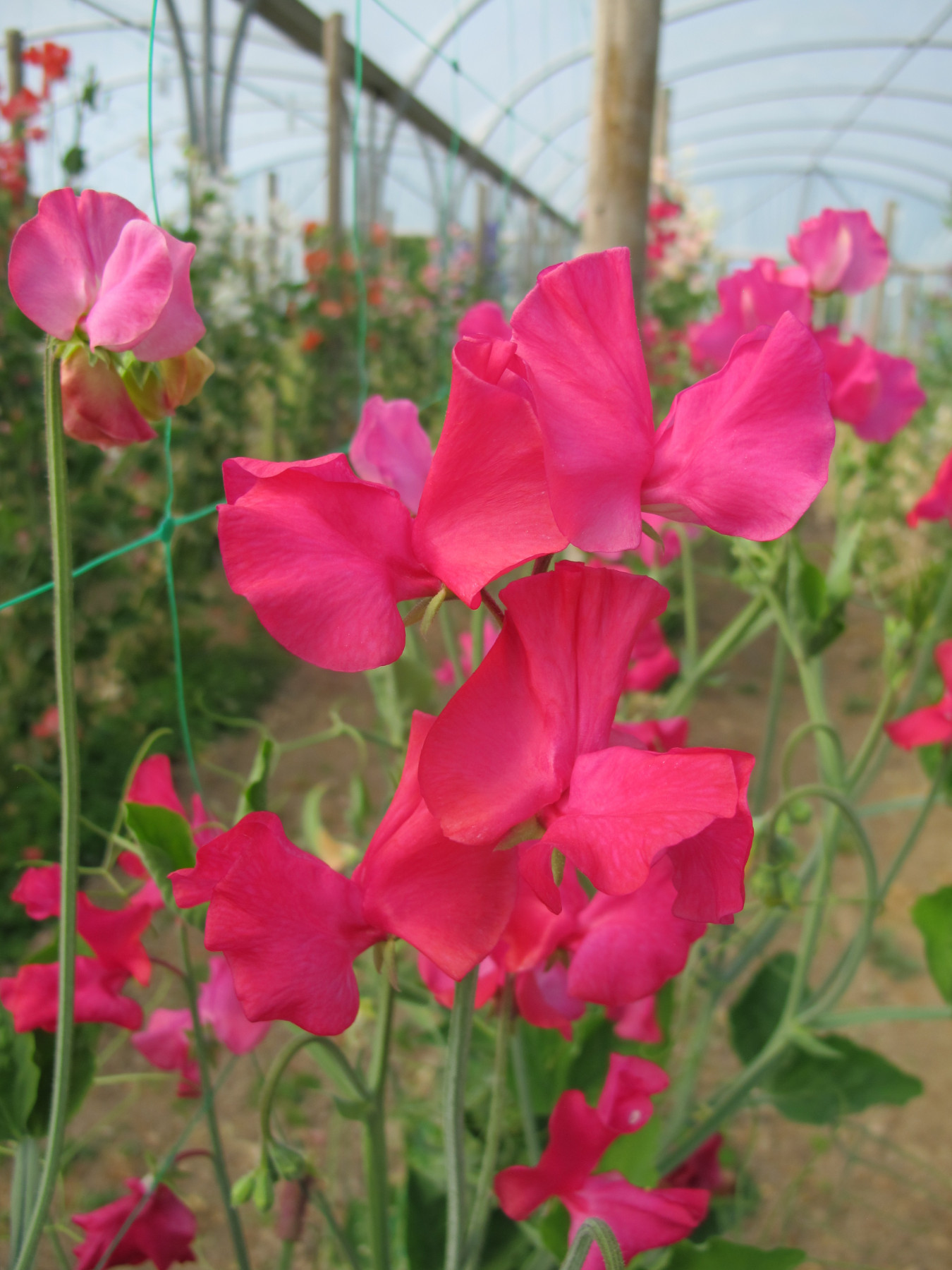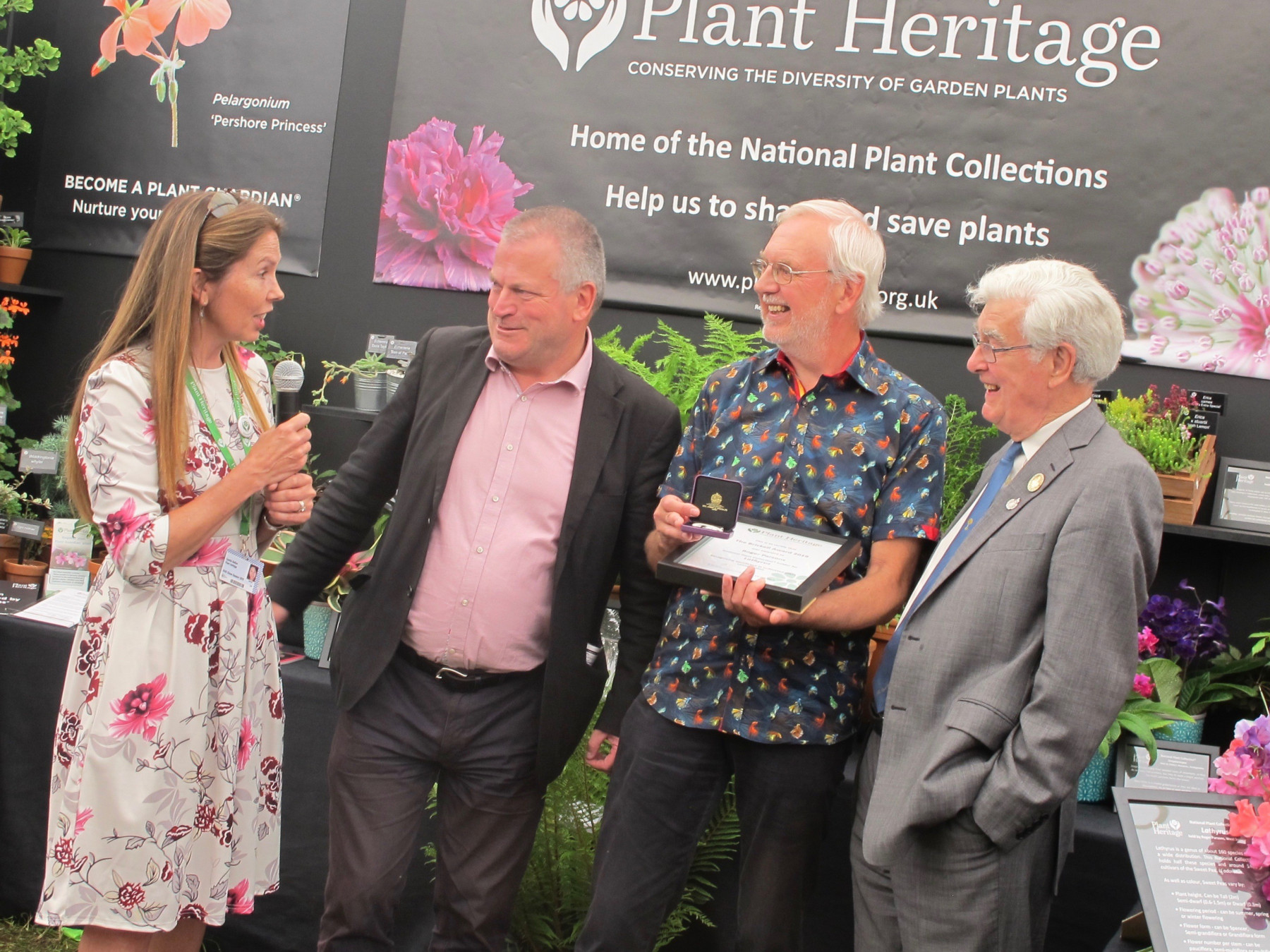
One of the glorious things about gardening is that you’re always thinking ahead, so I’m dreaming about the glories of next year just as the garden begins to fade. I’m planning to grow sweet peas again, because they are the ultimate cut and come again flower. Just a few stems on the kitchen table fragrance the whole room. And they speak of summer because their frilly flowers come in soft-blues, baby-pinks and clotted-cream. There are darker sweet peas, admittedly, but most are not as fragrant. ‘Windsor’ is the exception.
Gardeners have been in love with sweet peas for at least 200 years and the first seeds appeared in England even earlier, in 1699. They were sent to Dr Robert Uvedale, an Enfield schoolmaster, by a Sicilian monk named Franciscus Cupani. The flowers were thought to have blue and purple flowers and ‘Cupani’ seeds are still widely sold today. Seeds of ‘Painted Lady’ were offered for sale in 1724, but it seems to have changed colour over the years because Philip Miller, founder of the Chelsea Physic Garden, described it as a pale-red in 1731. This is still widely grown for its strong fragrance, although the deep-pink and white flowers are on the smaller side.

There are far more varieties now because sweet peas have always been popular with plant breeders, because they can be hybridised when they’re still in bud. If you’re growing sweet peas and they set seed, your seeds will come true to type because fertilisation happens before the flower opens. It was inevitable that larger-flowered sweet peas would appear and Henry Eckford ( 1823-1905), often called the Father of the Sweet Pea, began naming larger flowered fragrant varieties towards the end of the 19th century. Their arrival prompted sweet peas to become popular cut flowers, sold in London’s Covent Garden and other flower markets. These larger flowered sweet peas were known as Grandifloras, a term still used today.
One of Eckford’s pink varieties was named ‘Prima Donna’ and one or two stems of this variety began producing much frillier, wavy-flowered flowers all on their own. The first person to notice this was Silas Cole, Earl Spencer’s Head Gardener from Althorp Park in Northamptonshire. He named his frilly pink ‘Countess of Spencer’. A year later William Unwin, a cut flower grower from Histon near Cambridge, noticed the same type of flower on his ‘Prima Donna’. William Unwin went on to set up Unwin’s Seeds at Histon near Cambridge, a company once famous for its sweet peas. These frillier sweet peas became known as ‘Spencers’. They made good cut flowers and they exhibited well because they had long stems and the four blooms flowered all at the same time. Fragrance was variable however.
My own introduction to sweet peas came aged sixteen when I was a cadet nurse at the Warneford Hospital in Leamington Spa. The dispenser in the pharmacy was one Mr Bernard Jones and one summer’s day he came in with a bunch of pink sweet peas and gave them to me. Years later I found out that Bernard Jones was one of the most important sweet pea breeders in the world, although he never mentioned it to me! One of his best pink sweet peas was called ‘Mrs Bernard Jones’, after his wife. A rival breeder and friend, Colledge, named a variety Leamington – which must have annoyed Mr Jones because he lived in the town.

Seed stocks do deteriorate and buying seeds from a reputable stockist or specialist grower generally brings better results. In the summer I was lucky enough to visit Phil Johnson of Johnson’s Sweet Peas based near Colchester in Essex. He supplies seeds and plants via mail order and he sows his sweet peas in October because the seeds germinate easily and grow well in cooler conditions. Sweet peas like to be grown hard and, now that springs are warmer and come earlier, autumn sowing brings better results.
Phil recommends the following for strong scent, ‘Albutt Blue’ ( a blue-edged white Spencer) , ‘Matucana’ ( a maroon and violet bicolour) ‘High Scent’ ( a delicate white flushed with mauve ), ‘Kingfisher’ ( a washed violet) and ‘Sicilian Pink’ – a pink and white bicolour. Phil’s choice for cutting are the white ‘Memorial Flight’, the frilly rose-pink ‘Gwendoline’, the strongly scented maroon ‘Windsor’, the pale-blue ‘Naomi Nazareth’ and the frilly soft-pink ‘Alan Titchmarsh’.
It’s best to cut the flowers early in the morning, just after they’ve opened and, if flea beetle is a problem, leave them outdoors for a couple of hours. Phil’s varieties are available from Johnsons Sweet Peas
Roger Parsons is another sweet pea enthusiast and this year he was given The Brickell Award for his Plant Heritage Collection held at Bracklesham Bay in West Sussex. He has some new sweet peas in his 2019-20 catalogue, downloadable from www.rpsweetpeas.com .
‘Sativus Crescent Moon’ is a moody mixture of raincloud-blue with touches of bright-pink and a hint of green. ‘Alison Louise’, bred by Roger and named for his wife, is described as an “exceptional multiflora Spencer in a bright, mid blue.” ‘Cilla’ is a pale-bale spencer. ‘Sally Maitland’ is a strong magenta-pink. For what it’s worth, I’m fond of ‘Erewhon’, a blue and mauve ‘grandiflora’ type. Kings Seeds have an extensive range – www.kingsseeds.com well worth exploring.

If you like sweet peas Easton Walled Garden near Grantham has a Sweet Pea week, held at the end of June or beginning of July. Ursula Cholmeley has restored the 12-acre garden and sweet peas feature heavily. ( see www.visiteaston.co.uk ) They also sell seeds in pretty tins. Bramdean House in Hampshire, open by appointment for the NGS and also open on certain days, also grow many sweet peas. They’ve named a white ‘Bramdean’, after the garden.
I’ll be sowing mine at the end of this month and keeping them cool in my Hartley greenhouse. They can be sown up until November and one gardening friend always does his on Bonfire Night.
Roger Parson’s Growing Tips
Sow one seed per cell of 5” rootrainers, without the plastic cover, or sow 6 to 8 seeds to a 5inch (12.5cm) pot
Do not use bottom heat, 10C (50F) is the optimum for germination;
Do not soak or chip the seeds as this may reduce germination
Use a coarse multi-purpose compost and ensure seeds are covered by no more than 1/4 inch (5mm) of compost after sowing;
Do not firm the compost but water the pots with a fine rose;
Place the pots in a cold frame or cold greenhouse and protect against mice and slugs. Germination should take place after two weeks.
If you are sowing in late Autumn or Winter, your seeds may need a little gentle heat to germinate, e.g. on a kitchen windowsill, but do not use a propagator as it gets too hot;
To reduce the risk of fungal infection, the compost should be kept slightly dry after the first watering;
Make sure you move them to a cold greenhouse as soon as the young shoots break the surface of the compost, otherwise your plants will get elongated or ‘leggy’;
Plants should be given as much light as possible.
Plant out in final position in the spring. Dead head and water your plants in dry weather.

